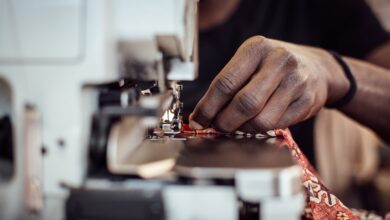
Floor graphics are a great marketing medium and, increasingly, an essential communication tool thanks to their effectiveness in guiding people around a space. Floor decals or markers require correct installation to avoid slips and trips. Most materials and adhesives designed for floor graphics applications are compatible with all common flooring types, but carpets can present an issue.
Specifically, some users may find that adhesion is challenging with new carpets. The same type of graphic applied to an old carpet within the same location could suffer no adhesion issues while installation on a new carpet could prove almost impossible. The reason may be the material, the coating, and even the design of the carpet.
Certain types of recycled, low-VOC, or environmentally friendly carpets may be “stain-resistant” or “never stain,” and their properties reduce adhesion. Often sold as carpet tiles, they are typically made from either durable and resilient nylon or polypropylene. Also known as olefin, polypropylene will not fade, will not absorb water, and can contain anti-staining additives, which also repel adhesives.
Additionally, polypropylene carpet will have a low surface energy (LSE) surface, which means it has a weak molecular attraction and is, therefore, harder to bond with other substances like adhesive. Combine LSE with anti-staining additives, and you get a surface that is very difficult to adhere to, very much like low-VOC latex/Teflon paint on walls. Usually, removable adhesive takes 48 hours to wet out properly, but with this new type of carpet, the adhesive does not wet into the surface.
Floor graphics products are generally rated for application to low-pile, industrial grade, smooth-surface carpet. Textured carpet (any design with ribbing, grooves, or cut-outs) is not compatible because the textured surface has far fewer adhesion points for the glue to stick to.
To ensure the suitability of a floor graphics product, we recommend performing an adhesion test before proceeding. No one wants to spend time and money on a project that fails. This is especially important with floor graphics because the loss of adhesion can pose a safety hazard.
One option is using a permanent adhesive, which risks leaving residue on your floor surface. Fortunately, there are temporary alternatives to explore like polymeric PVC film. This film can be applied to virtually any type of flooring, including short-pile carpets, providing a non-slip surface for interior graphics for up to nine months when paired with a recommended overlaminate.
Monomeric PVC film and PVC-free polyester film are two other great short-term floor graphics solutions that can last anywhere from three to nine months, depending on lamination.




